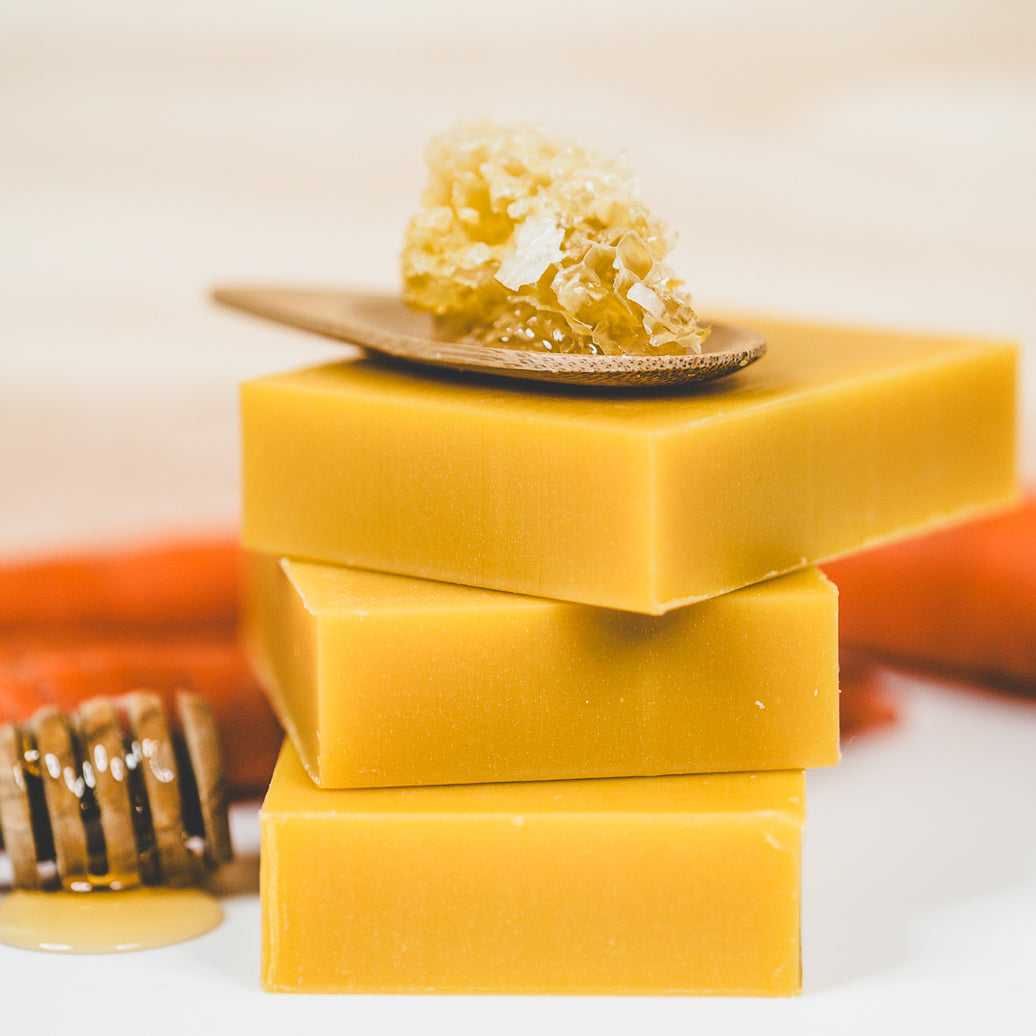
Natural Soap: Carrot & Honey Complexion
- Out Of Stock
As adults, we often wish for soft, silky baby skin because we think a baby’s skin is perfect.
 But baby skin needs a lot of TLC. From diaper and heat rashes to eczema to dry patches, their skin can get irritated quickly.
But baby skin needs a lot of TLC. From diaper and heat rashes to eczema to dry patches, their skin can get irritated quickly.
Developing a good baby skincare routine using the right newborn baby skincare products is extremely important.
The delicate skin of a newborn is not mature at birth. It continues to develop over the first year of life, and babies have a lot of skin for their small bodies.
Compared to an adult, the cells are smaller, the skin is much thinner and more prone to dryness. A baby’s sensitive skin is also more permeable (allows stuff to pass through) than adult skin which makes them more vulnerable to any substance applied to the skin.
Clothing, detergents, and baby products that contain chemicals, fragrances, or dyes can cause dryness, irritation, and rashes on newborn skin.
Babies need simple skin care like gentle organic plant butters and oils that will nourish their young skin as it learns to adapt to its new environment. We believe that nature provides all of the nourishing ingredients we need.
So keep it natural from their first day!
Do you need to bathe your baby every day? That really depends on your baby.
Many websites say that young babies only need to be bathed a few times a week since they don't really get dirty, they just drool and poop.
 However, my own three beautiful babies and my five grandbabies, all breastfed, did not simply drool and poop. They often spit up and exploded out of their diapers, which at times required more than one bath a day.
However, my own three beautiful babies and my five grandbabies, all breastfed, did not simply drool and poop. They often spit up and exploded out of their diapers, which at times required more than one bath a day.
In my day there were no "baby wipes." Today, even if you can find natural baby wipes or make your own, the gentle wiping that is necessary to prevent irritation will often not thoroughly clean all those lovable baby creases.
Gentle cleansing is the most important step in baby skincare. Choose a mild baby soap with soothing ingredients and stay away from detergent body washes that can strip the skin of its natural oils.
Lukewarm water in a baby bathtub or basin, a soft gentle cotton washcloth, and mild natural soap will do the trick. Apply a small amount and massage it all over the body paying special attention to the diaper area, the hands, between toes, the adorable thigh creases, and the folds under the neck. Rinse with lukewarm water.
After bathing, pat your baby completely dry. Pay special attention to baby skin folds and groin area or they can retain moisture and cause skin problems. Apply an organic baby moisturizer immediately after the bath. We recommend our Baby Body Balm or Unscented Baby Oil.
Routine bath time should be a calming experience for you and your child. Choose a time when you are relaxed and try not to bathe your baby when they are hungry or right after a feeding. If bathing relaxes your baby, it is a great activity before bedtime. Babies often sleep longer after an evening bath.
Most newborns don’t like to be naked. They can feel "vulnerable," cry, and exhibit the Moro (startle) reflex when placed in a bathtub. Try placing a small wet warm cotton washcloth over their body in the tub which may help the baby feel more secure.
Your baby may not need to be bathed with soap every day. Some days a simple relaxing bath is all that is needed to keep your baby clean. Our Baby Bath Herbs are a comforting, gentle blend of organic botanicals that soothe the skin and help relax fussy babies. You can also make your own by placing some gentle herbs and oatmeal into a muslin bag.
Remember, do not submerge babies into the water if they still have their umbilical cord stump. You want the cord stump to dry up and fall off on its own, which usually happens by about one or two weeks of age. The Academy of Pediatrics recommends only sponge baths until that time.

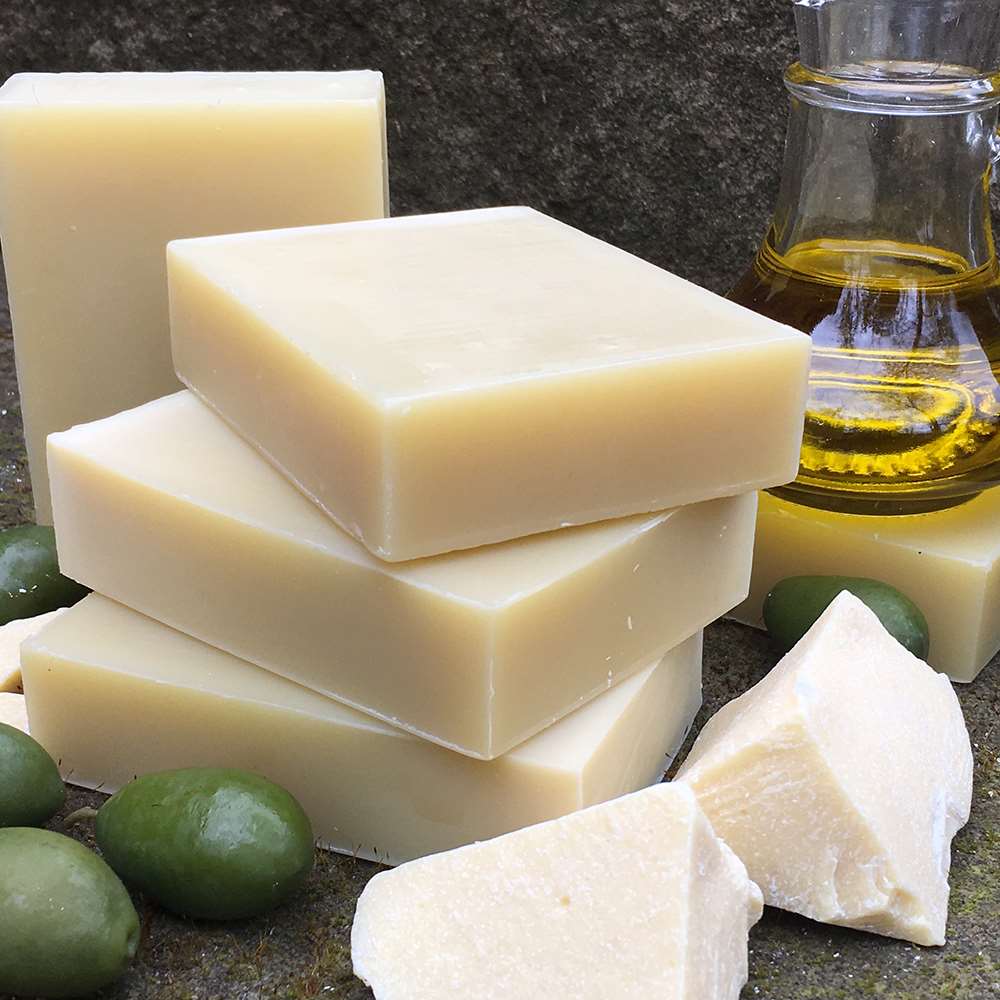
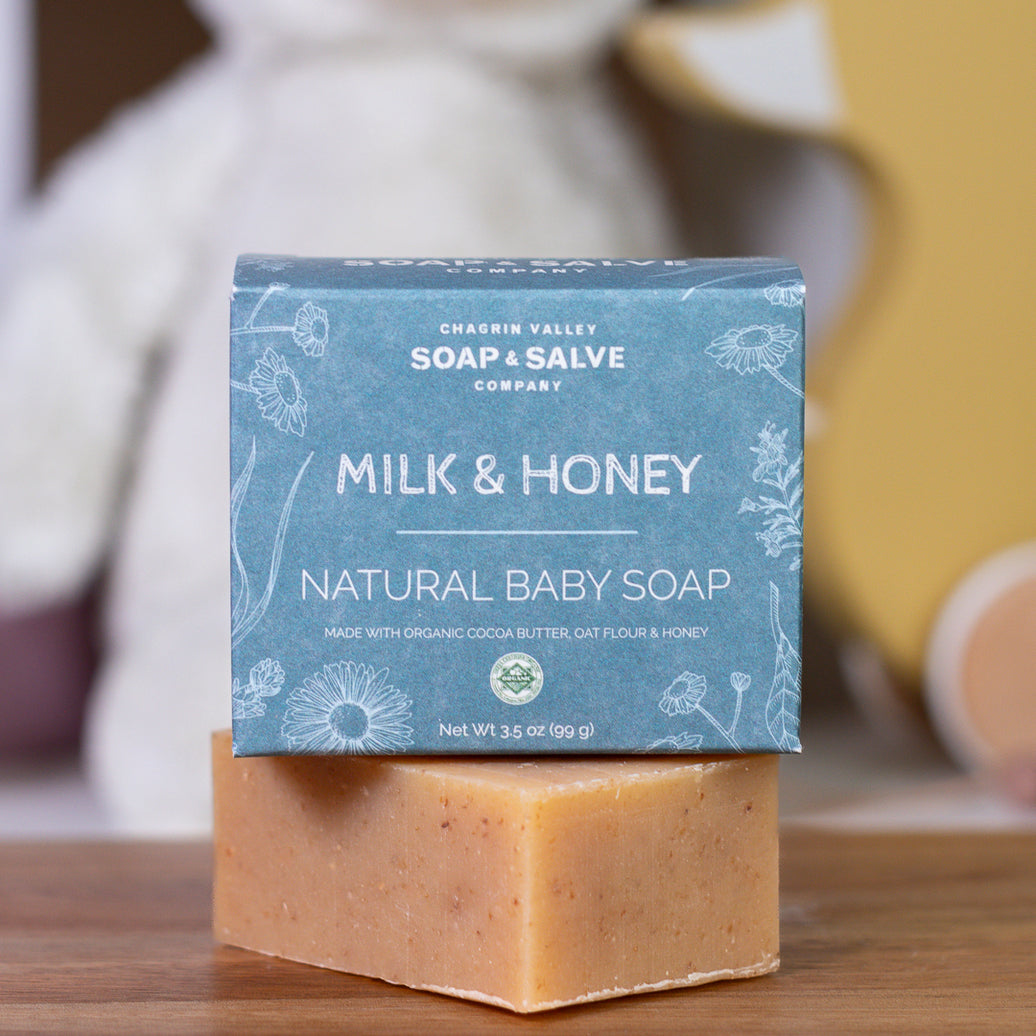
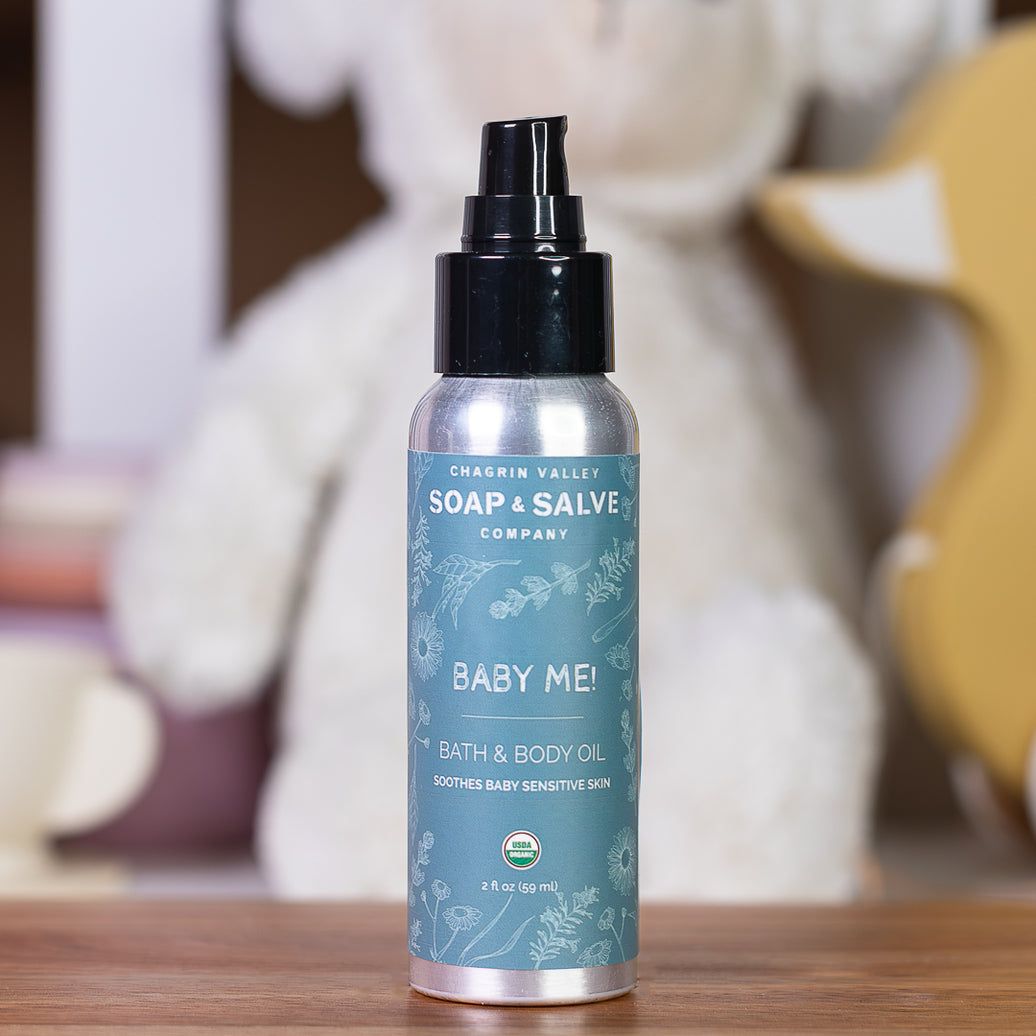
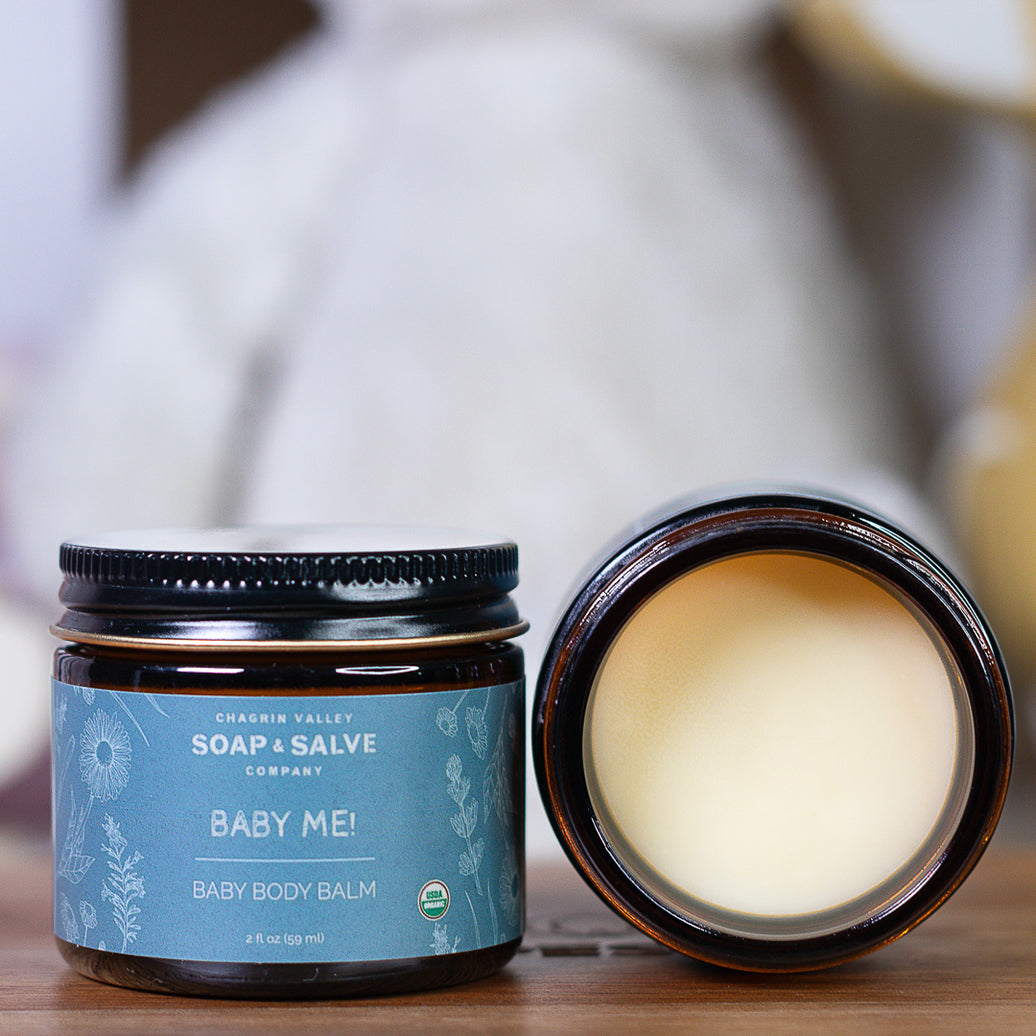
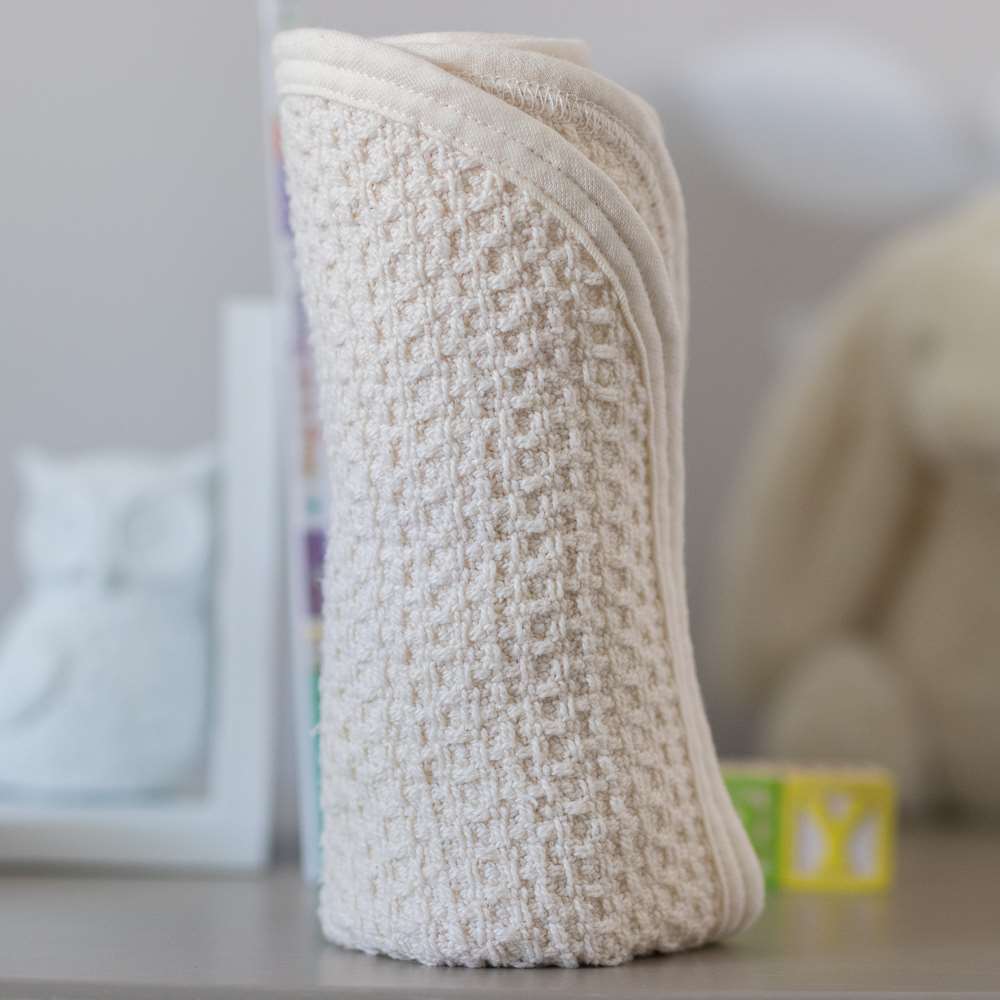
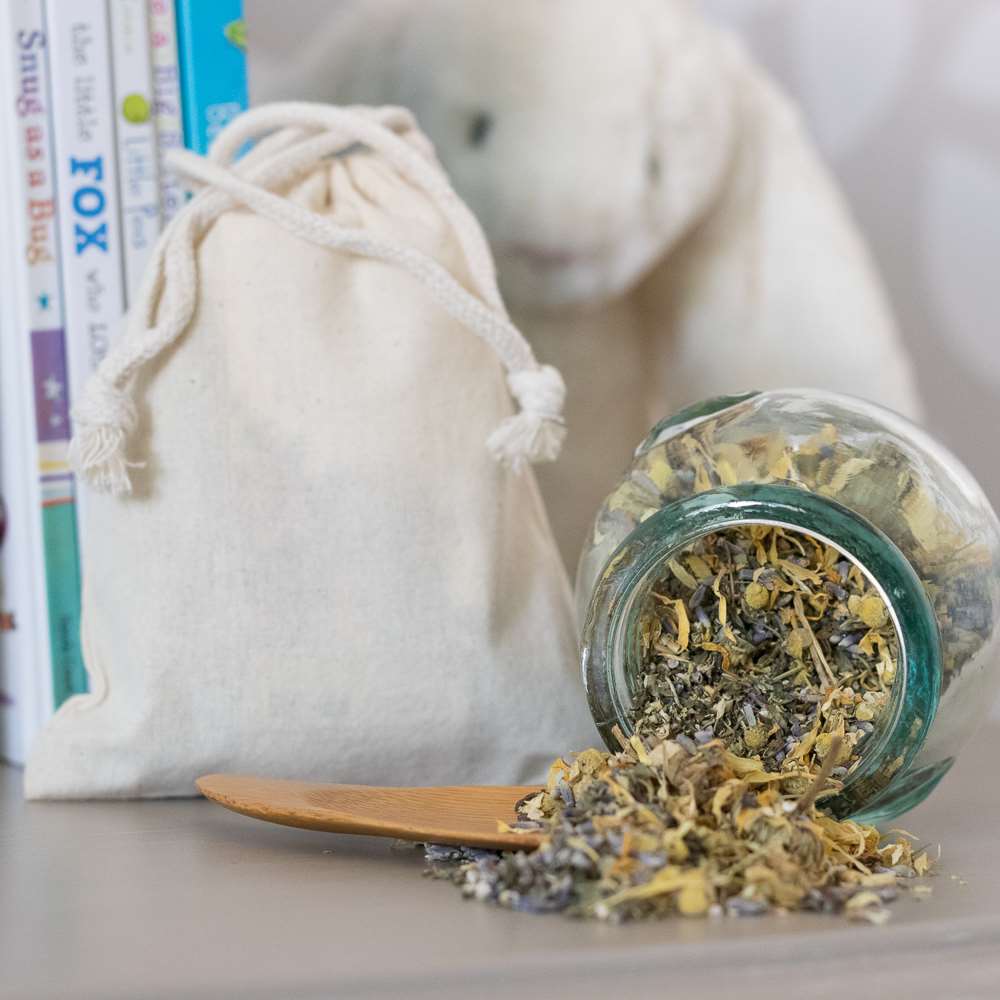
 Diaper rash is generally caused by moisture in the diaper area causing a wet environment.
Diaper rash is generally caused by moisture in the diaper area causing a wet environment.
When skin stays wet for too long it begins to break down. The baby's skin becomes red, irritated, and prone to chafing. Painful sores can develop, and the baby becomes vulnerable to yeast and bacterial infections.
Harsh soaps or wipes, sweat, moisture from soiled diapers, allergies to diaper material, foods or products used on the skin, or diapers that are too tight can cause a rash or worsen an existing rash.
The best prevention for diaper rash is to keep your baby's skin as clean and dry as possible.
With each diaper change, clean the area thoroughly. I prefer a cotton washcloth with warm water to commercial baby wipes, there are fewer chemicals to cause irritation and it is easier to clean the little folds where urine and stool can hide without scrubbing.
Gently pat the skin dry with a clean towel and apply a thin layer of a mild, unscented organic baby balm or cream to the diaper area. Stay away from water-based lotions. They do not offer a good moisture barrier and require preservatives. We recommend our Baby Body Balm to help prevent rashes.
At the first sign of irritation, switch to our Baby Bum Salve formulated for diaper rash.
Note: Don’t become so overly anxious about diaper rash that you are constantly wiping and scrubbing the diaper area. All that friction on moist skin can weaken the protective barrier of the skin and contribute to diaper rash.
Generally, diaper rash can be treated successfully at home, but if you are concerned at all, ALWAYS consult your baby’s health care provider
Since a severe diaper rash may need medical attention, please consult with your baby’s health care professional.

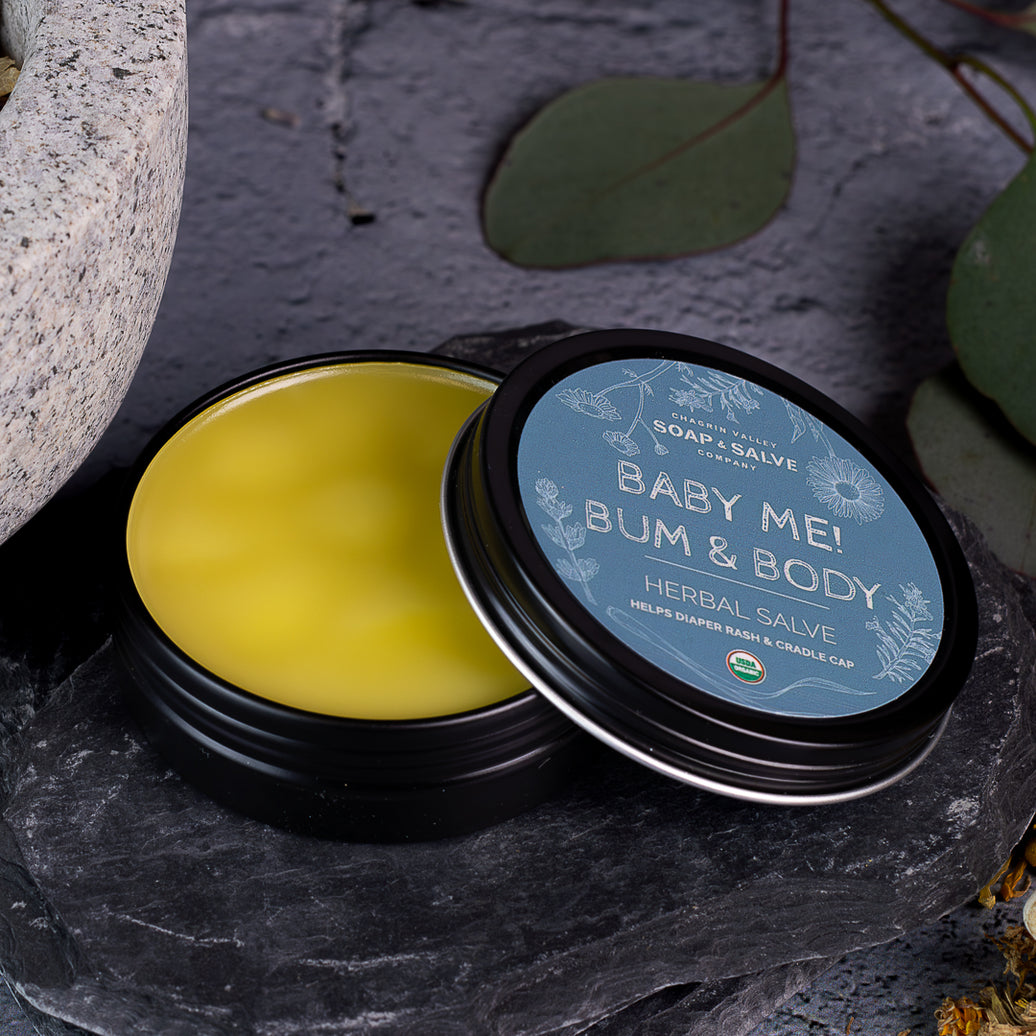

Almost every baby will deal with dry skin from time to time. Baby skin is not mature at birth, continues to develop over the first year of life, and is also adjusting to the new environment outside the womb. Babies have a lot of skin for their small bodies, and compared to an adult, the cells are smaller, and the skin is much thinner, more sensitive, and more prone to dryness.
 Dry patches can be found anywhere, but they are especially common on the hands, feet, face, and lips. Rough, flaky skin is a sign that your baby’s skin needs more moisture. While a mild case of dry skin will not bother your baby, very dry skin can become itchy and lead to scratching and irritation.
Dry patches can be found anywhere, but they are especially common on the hands, feet, face, and lips. Rough, flaky skin is a sign that your baby’s skin needs more moisture. While a mild case of dry skin will not bother your baby, very dry skin can become itchy and lead to scratching and irritation.
Although dry skin and eczema have some symptoms in common, there are a few ways to tell the difference.
Patches of eczema not only look rough or scaly but the skin can also be inflamed. The skin may look red or pink, in children with lighter skin, or red-brown, purplish or grayish in children with darker skin.
While both eczema and dry skin are common on your baby’s hands, feet, face, and lips, eczema patches are often found behind the ears, on the scalp, neck, ankles, elbow creases, or behind the knees. Skin with eczema may also develop tiny, fluid-filled pimples that eventually burst. The baby may be fussy or find it difficult to settle or sleep due to chronic itchiness.
Eczema, also known as a type of atopic dermatitis, affects every child differently. There are often environmental triggers that cause irritation such as fabric material, topical skin care products, pet dander, detergents used for laundry, and foods as they get older.
Since baby skin is so delicate and their immune systems are not fully developed, always consult your child's health care provider if you are at all concerned about a skin condition. Some can be quite dangerous.
Although a doctor may treat dry skin and eczema differently, for the purpose of recommending natural skin care products the care is similar.
Daily bathing and moisturizing are key. A lukewarm bath hydrates and cools the skin and may also ease itching. A 5 to 10 minute soak is all they need. Do not scrub irritated skin and use only a gentle baby soap if needed.
To help soothe itchiness our Baby Bath Herbs are a gentle blend of organic botanicals and oats. You can also make your own by placing some oatmeal into a muslin bag.
Gently pat your baby dry and immediately apply an organic moisturizer to help seal in moisture while the skin is still moist and damp. Avoid water-based lotions since they do little to lock in moisture. Choose a gentle organic baby oil or a baby cream with a thick consistency and high oil content. We recommend our unscented Baby Bath Oil or our Baby Body Balm.
Unfortunately, your baby will not tell you that they feel itchy. So, stay a step ahead of the problem by scheduling times throughout the day to moisturize their skin.
It is a good idea when trying any new product on your baby to do a patch test on a small area of the child's skin to make sure it is well-tolerated.
Dress your baby in comfortable clothing. Avoid tight or scratchy fabrics that can irritate a baby’s skin. Cotton is a good choice due to its soft texture and breathability. Always wash new clothes in a mild fragrance-free soap or detergent before you put them on your baby.



Heat rash, also called prickly heat, is a common problem in children, especially babies. It is caused by blocked sweat glands and sweat that is trapped beneath the skin.
You will usually see small red bumps on the skin that can appear anywhere but most often on the neck, bottom, and skin folds. The rash may cause itchiness or a prickly feeling.

It is common during hot, humid weather, especially when your baby is exposed to too much sun or heat or is overdressed. Since we know that babies lose heat more quickly than adults, we tend to overdress them.
No matter what the temperature was outside, any time my dear mom would feel cool hands, she insisted my babies needed more clothing.
Prickly heat can even appear in winter when your baby is over-bundled. Try dressing them in layers so that you can easily remove clothing if they seem warm.
To help relieve symptoms, a cool or lukewarm bath can soothe the skin and may also ease itching. To help calm itchiness our Baby Bath Herbs are a gentle blend of organic botanicals and oats. You can also make your own by placing some oatmeal into a muslin bag. Pat your baby dry, and don’t forget those cute little folds!
We have also found that a small amount of organic fragrance-free, talc-free baby powder massaged onto areas where the clothes can cause chafing or in skin folds can help.
Our Unscented Baby Powder is formulated with finely milled vegetable root powders and silky clay that work together to absorb moisture to help keep skin dry. Although many natural baby powders substitute cornstarch for talc, cornstarch can promote the growth of yeast and exacerbate rashes—so we don’t use it! Sprinkle a small amount of powder into your hands and then gently massage onto the baby’s skin.
A cool, dry environment and loose-fitting, natural fiber clothing can also help.
Contact your baby’s health care provider if the rash does not improve within a few days, if the skin appears infected, or if your baby develops a fever or displays any signs of illness.
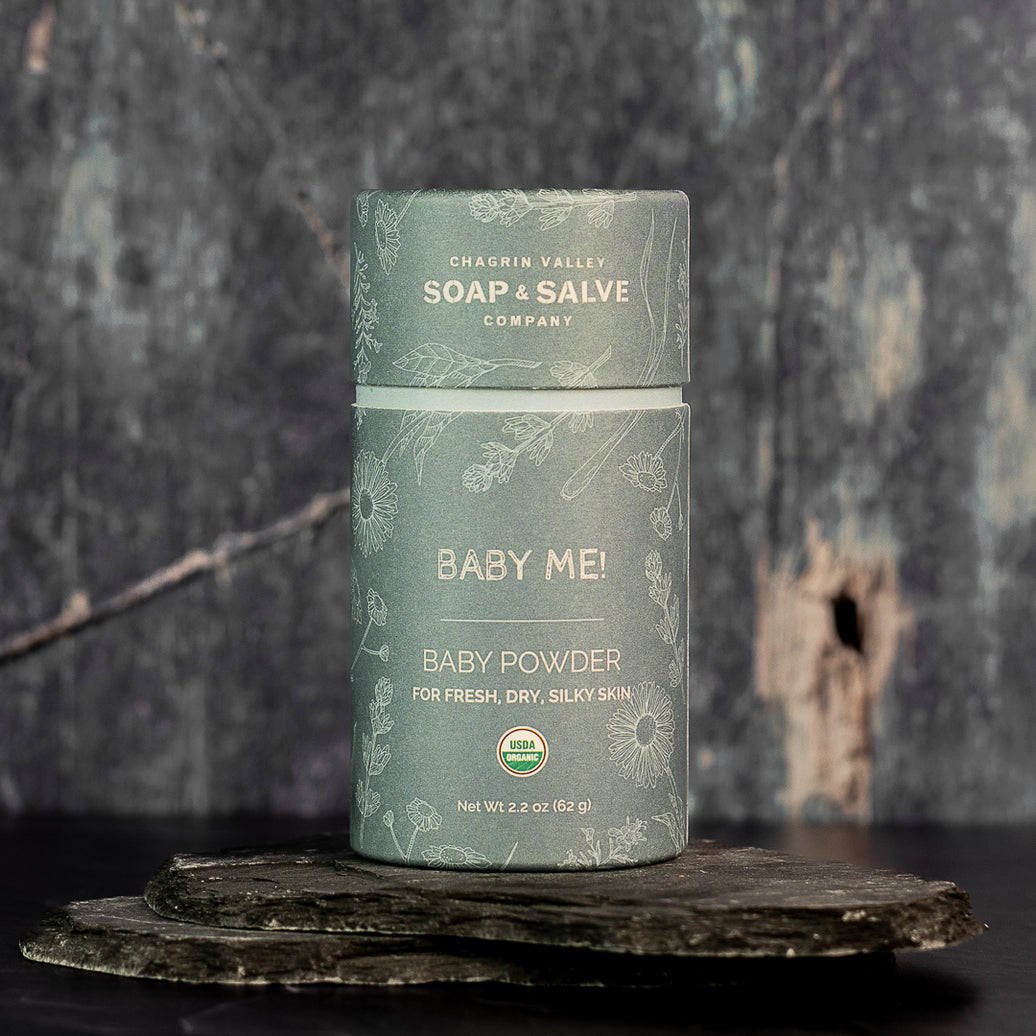

Everybody seems to love chunky baby thighs, but all those adorable folds can get quite stinky. Sometimes, you will actually find white “Cheesy looking” stuff in the creases of a baby's skin.
It can get really warm and sweaty inside skin folds. Since the area is constantly moist, some of the baby's skin rubs off from friction—thus the “cheese.” It is often found in chubby baby folds, under the arms, in the groin area, and on the neck.
 Baby neck cheese is quite common and often results from drool, milk, and moisture that irritates the folds. It is especially common in younger babies who cannot hold their heads up, which prevents air circulation in the neck area.
Baby neck cheese is quite common and often results from drool, milk, and moisture that irritates the folds. It is especially common in younger babies who cannot hold their heads up, which prevents air circulation in the neck area.
It is important to separate the folds of the neck and gently wipe the area clean after every feeding. Using warm water and a washcloth or cotton ball will usually cause less irritation than baby wipes which may irritate delicate skin.
Keeping all of their little folds clean and dry is especially important. During bath time separate folds and wash with mild baby soap. A small squirt bottle filled with warm water can help better rinse the area.
Separate the folds to pat dry. If your baby is quite chunky, be mindful to check the problem areas a few times a day. For spot treatments, use a cotton ball with a bit of natural soap to gently cleanse the folds and pat dry. Remember that you do not want to leave the skin damp.
There are two trains of thought as to how to care for stinky baby folds. One is to use a thick organic cream, like our Baby Body Balm, or natural oil, like our Baby Bath Oil in order to “grease” the area and reduce friction.
The other thought is to use a talc-free, fragrance-free, organic absorbent powder, like our Unscented Baby Powder, to help absorb perspiration and keep the area dry.
If there is no rash or irritation, these methods along with regular bathing can help alleviate the issue.
However, more severe cases might have a rash, mild irritation, or skin that has cracked open or is raw. The moisture and warmth make skin folds a perfect environment for bacteria and fungi to multiply.
If you are concerned or do not see improvement, please contact your pediatrician.




Cradle cap is common in young infants. It usually appears on the scalp and occurs most often between the ages of two and six months.
Your baby may experience a mild form with flaky, dry skin that looks like dandruff. A more severe case will have thick, oily, yellowish, or brown scaling or crusting patches.
 As the scales flake, they may make the affected area look red. Sometimes, the hair will come away with the flakes, but it will grow back.
As the scales flake, they may make the affected area look red. Sometimes, the hair will come away with the flakes, but it will grow back.
Cradle cap is not contagious, usually harmless, and generally does not bother babies. While it is often confused with infantile eczema, cradle cap does not cause itching.
Cradle cap is typically found on the baby's scalp, but you may also notice some patches around the nose, ears, eyebrows, eyelids, armpits, and other creases behind the knees and groin area.
Cradle cap is an inflammation of the oil-producing glands in the scalp. Although the cause is not known, some experts believe that hormones released by the mother during the final stages of pregnancy over-stimulate the baby's oil-producing glands.
These oil-producing glands, known as sebaceous glands, are found in the skin and produce an oil-like substance known as sebum. The greatest concentration of sebaceous glands is found on the face and scalp.
With cradle cap, these glands produce too much sebum. As a result, old skin cells that normally dry and slough off now stick to the scalp.
While there is no definite treatment for cradle cap, there are some suggested tips to help.
Our Milk & Honey Baby Soap makes a great natural shampoo. Create a bit of lather in your hands and shampoo away. While we only use simple, natural, and organic ingredients, it is soap, so take care to keep soap away from baby's eyes.
Just before shampooing, gently massage the baby's scalp with your fingers or a very soft brush to help loosen the scales. Some people have found that a very soft toothbrush is easier to use on a baby's little head, especially to target small areas.
When using a brush, remember that your baby’s scalp is very sensitive. Use only a very soft brush made for babies and do not brush too hard or focus on the same spot for too long. The goal is NOT to remove all of the scales in one day, it will take time.
Once the scales disappear, repeat a gentle washing every few days to prevent their return.
Before shampooing soften the scales with a light, organic baby oil first. Gently massage the oil into the scalp with your fingers and wait about 15 -30 minutes. To help further loosen the scales you can use a brush on the oiled scalp before shampooing. This is where I find a soft toothbrush very helpful. An oily toothbrush is easier to clean after use and is also disposable. Again, remember the goal is NOT to remove all of the scales in one treatment.
Our family likes our Baby Me! Unscented Bath & Body Oil made with the light moisturizing and soothing organic oils of jojoba and sunflower.
While some recommend olive oil, it is heavy, can become quite sticky, and is difficult to wash off. An organic sunflower oil may be a better choice. Be sure to shampoo well after oiling. You do not want to leave the oil on the baby’s head, which may clog pores and exacerbate the problem.
Other Information:
Some researchers believe that cradle cap may be due to an overgrowth of a yeast-like fungus called Malassezia. While Malassezia is a normal inhabitant of the scalp, for some, this yeast-like fungus grows out of control, irritates the scalp, and causes excess skin cells to grow and build up on the scalp.
Our Baby Me! Organic Baby Bum Salve is made with healing herbs and antifungal wildcrafted myrrh that may help prevent or decrease fungal growth.
Don't use over-the-counter cortisone or antifungal creams or dandruff shampoos without talking to your baby's doctor. Many of these products can be toxic when absorbed through a baby's skin.
Never pick at the crusts on your baby's scalp, as it could lead to infection. If the scalp looks red or irritated or starts weeping, it could be a sign of infection.
Cradle cap is rarely a serious condition, but as a concerned parent you can never be too cautious when dealing with an infant—always consult your health care provider if you have any concerns.



Babies thrive on touch. Massaging your baby enhances the emotional bond, provides a calm experience, improves sleep patterns, improves circulation, helps develop sensory awareness, and can even be used to soothe tummies and support digestion.
 It is a relaxing and fun activity that moms, dads, grandparents, caregivers, and even older siblings can enjoy with the baby.
It is a relaxing and fun activity that moms, dads, grandparents, caregivers, and even older siblings can enjoy with the baby.
Remember, perfect technique is not what matters! Your loving, warm gentle touch is what is most important.
Since a baby's skin is so sensitive it is a good idea to test any oil used for massage on a small spot of your baby's skin and wait a day to be sure no irritation appears. Read about doing a patch test
Gather the items you need before you begin your massage. This includes baby massage oil, clean diapers, towels, clothes, etc. I like to make lists!
Stop the massage if your baby starts to fuss or seems uncomfortable. Avoid massage time if you are tense or if your baby is upset. Make sure your fingernails are short.
Most of all, enjoy this precious time with your little one. Wrap the baby in a clean and warm towel after the massage and cuddle, cuddle, cuddle!



The best sun protection for these infants is to stay in the shade. Keep an umbrella handy in case shade is not available.
While some parents use sunscreen, I tend to shy away from sunscreen on young infants because infants are at greater risk than adults of sunscreen side effects, such as a rash.
 Dress your baby in clothing that will provide a physical barrier to protect their skin from the sun's rays, such as a lightweight, natural fabric sleeper or a long-sleeved shirt, pants, and of course a hat that will also protect their neck, face, and ears.
Dress your baby in clothing that will provide a physical barrier to protect their skin from the sun's rays, such as a lightweight, natural fabric sleeper or a long-sleeved shirt, pants, and of course a hat that will also protect their neck, face, and ears.
Trim your baby’s nails whenever they get sharp to prevent scratches. If the idea of using scissors on the little fingers is scary, use an emery board to shape the nails and remove jagged edges.
Baby clothes are so adorable! While I know we want to put that cute outfit on right away, to protect your baby’s sensitive skin, always wash new clothes before wearing them.
Use fragrance-free and dye-free detergents only. It is also best to wash the baby’s clothes and bedding in a separate load from family clothes.
Don't forget to also wash baby blankets, sheets, and towels before use.
NOTE: It is a good idea when trying any new product on your baby to do a patch test on a small area of the child's skin to make sure it is well-tolerated.
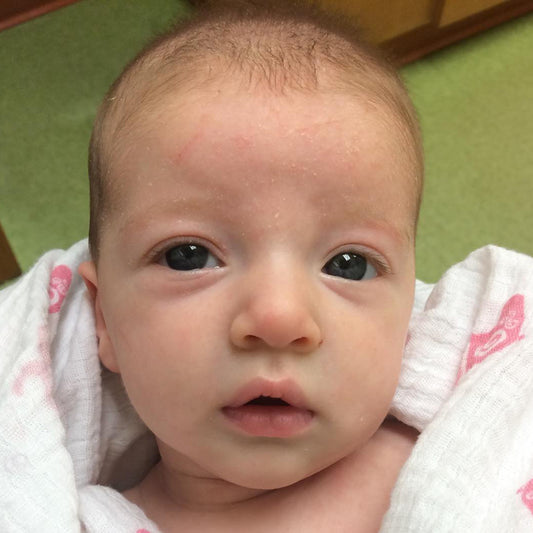
Cradle cap is very common in young infants. It usually appears on the scalp and the symptoms can vary from simple dandruff-like flakes to oily, yellowish, or brown crusting patches.
Read Post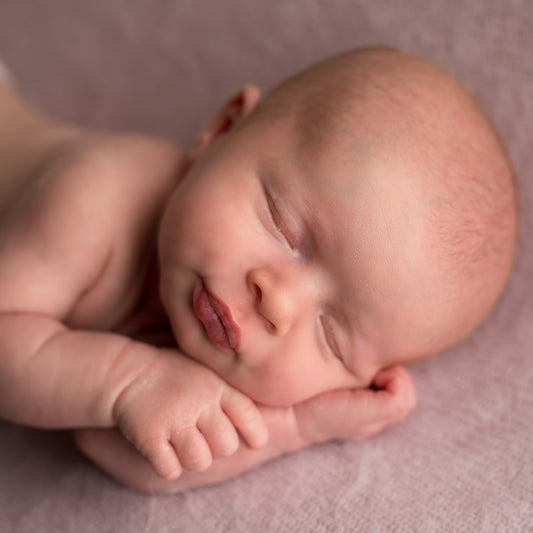
Young babies thrive on touch. Massaging your baby enhances the emotional bond, improves sleep patterns, helps develop sensory awareness, and may help soothe tummies and support digestion.
Read Post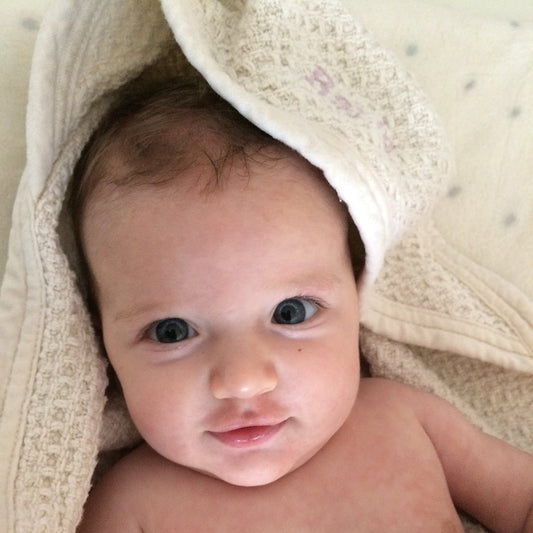
From the day we are born, our skin is our first line of defense against germs, water loss, outside heat and cold, and it helps regulate our body temperature. Your skin deserves organic skin care!
Read Post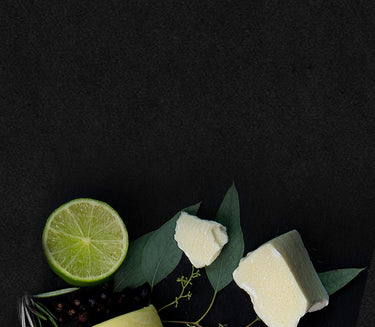

People with severe allergies—please note: If you have severe anaphylactic-type reactions to ANY of the ingredients in ANY of our products, please do not buy our products. We have dedicated soap rooms and product rooms that are kept meticulously clean, but we cannot guarantee against possible cross-contamination of individual ingredients.
Chagrin Valley Soap & Craft is not responsible for any individual reaction to any particular ingredient. Each product description on our website includes a complete list of ingredients. People with sensitivities to any listed ingredient should not use the product. In case you are in doubt always try an allergy patch test and if at any time irritation occurs, discontinue use of the product.
The content and information on this website, provided by The Chagrin Valley Soap & Salve Company, is for educational purposes only and is in no way intended and should not be construed as medical advice to diagnose, treat, cure, or prevent any disease or health condition. The information regarding folklore or health-related benefits of certain ingredients is for educational purposes only. The information provided is not intended to prescribe or be taken as medical advice.
The information provided is not meant to substitute the advice provided by your personal physician or other medical professionals. Do not use the information found on this website to self-diagnose any medical conditions or treat any health problems or diseases. If you have medical concerns regarding yourself or your family you should seek the advice of qualified, licensed health professionals. Never disregard professional medical advice or delay in seeking it because of something you have read on this website.
This information has not been evaluated by the Food and Drug Administration. This notice is required by the Federal Food, Drug and Cosmetic Act.
Read our Full Medical Disclaimer.